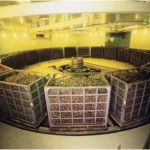Irradiation in Australia & New Zealand
Note: this page is available in pdf flyer format here, Blueberry Flyer.
Irradiated food? Coming to a supermarket near you…
Irradiation is the process of exposing food or other materials to ionising radiation. Food irradiation is used for shelf-life extension and for neutralising, not removing, contaminants or pests.
Irradiated superfoods?
Food Standards Australia New Zealand (FSANZ) has recently added 12 commonly eaten fruits to the irradiation approvals list and is now considering approving irradiation for Blueberries and Raspberries.
The expanding list of approved foods, significantly increases the proportion of potentially irradiated foods in the average Australian and New Zealander diet.
Irradiated fruits – marketed as “fresh” – are exposed to 150Gy – 1kGy of radiation, which is equivalent to approximately: 1.5 million – 10 million chest x-rays per exposure.
So far, these foods have been approved:
Apples, Apricots, Breadfruits, Capsicums, Carambolas, Cherries, Custard Apples, Grapes, Herbal Teas, Herbs, Honeydew, Longans, Lychees, Mangoes, Mangosteens, Nectarines, Pawpaws, Peaches, Persimmons, Plums, Rambutans, Rockmelon, Spices (general), Scallopini (Squash), Strawberries, Tomatoes, Zucchini.
FYI: Pet food, therapeutic goods and animal feed are also allowed to be irradiated without labelling as they are not “food” under Australian law.
Irradiation decreases the vitamin and nutritional content of food and disrupts its molecular structure, producing free radicals and potentially harmful chemicals such as benzene, formaldehyde and cyclobutanones.
Nukes & our food: Australia has 3 commercially operating nuclear irradiation facilities. All use radioactive Cobalt-60 produced in Canadian reactors to zap our food and other products. These factilities are run by a private company, Steritech Pty Ltd and are located in: Dandenong, Vic., Wetherill Park, NSW, and Narangba/Deception Bay, Qld. The Narangba/Deception Bay facility has been designed specifically to irradiate food.
New Zealand: There is also an Australian Quarantine and Inspection Service (AQIS) approved irradiation facility in New Zealand – Schering Plough Animal Health Upper Hutt, New Zealand.
How will I know if it’s irradiated?
Irradiation is invisible. Shoppers cannot tell if fruit has been irradiated simply by looking at it. Labelling is the only way to distinguish irradiated foods from non-irradiated foods.
Will it be labelled?
Food Standards Australia New Zealand (FSANZ) is considering getting rid of mandatory labelling for irradiated foods.
The industry and government know that people are reluctant to eat irradiated food. The industry sees labelling as an impediment to consumer acceptance and therefore constantly seeks to weaken or remove labelling requirements. They would prefer us to be kept in the dark.
Removal of labelling would be deceptive. Without labelling, irradiated foods would appear to be Current laws also allow shops to use a sign close by to produce, rather than actual stickers or labels. fresh, though they are, in fact, processed. Consumers would not be able to make informed choices.
Rather than removing labelling, FSANZ should be improving it.
Under current laws, there is no specified wording required for the labelling statement, leaving the messaging up to the company. Neither the word radiation nor irradiation is required. This has got to change!
This is not good enough! Irradiated produce should be individually labelled.
Is it safe?
The science on the safety of irradiated food is, at best, divided. Claims that irradiated food is safe are misleading as no long-term study of human consumption of an irradiated diet has been carried out. As a pest control “treatment”, irradiation is unnecessary as numerous alternatives exist.
In 2008, up to 100 Australian pet cats suffered neurological disease linked to eating irradiated cat food.
The Australian government has since banned the irradiation of cat food, but continues to expand the list of foods permitted to be irradiated for human consumption.
This is unacceptable!
Become a Food Irradiation Watcher!
To avoid irradiated food, Food Irradiation Watch advises shoppers to read packages carefully and to look down at produce to see if there is an irradiation sticker and then look up to see if there is a sign. If you do find irradiated products, let us know!
Good food doesn’t need irradiating!
Irradiated food does need labelling!
- Choose to eat irradiation-free foods!
- Demand stronger irradiation labels!
- Alert your supermarket, greengrocer and politician
- Sign up to help ensure irradiated foods stay off our tables!l
Get involved in the campaign!
Food Irradiation Watch
T: 61 411 118 737
E: foodirradiationwatch@yahoo.com.au
F: facebook.com/notofoodirradiation
www.foodirraditionwatch.org

